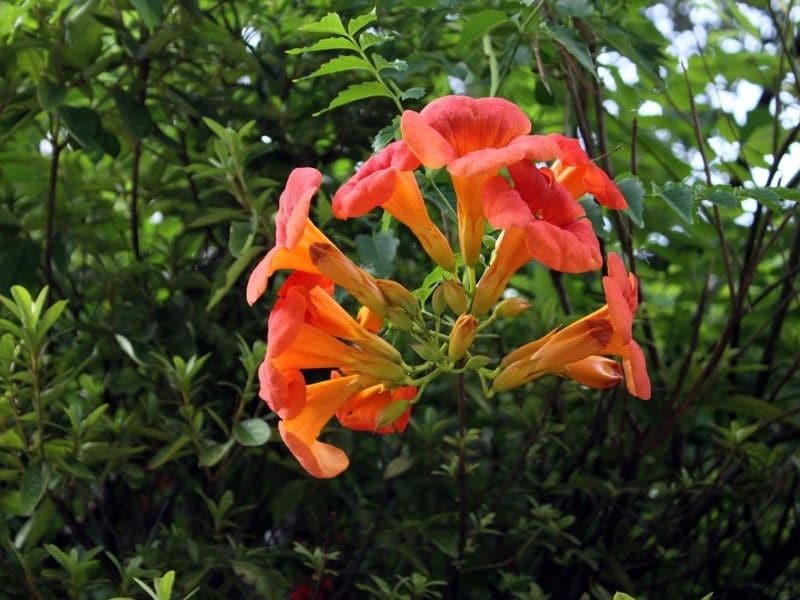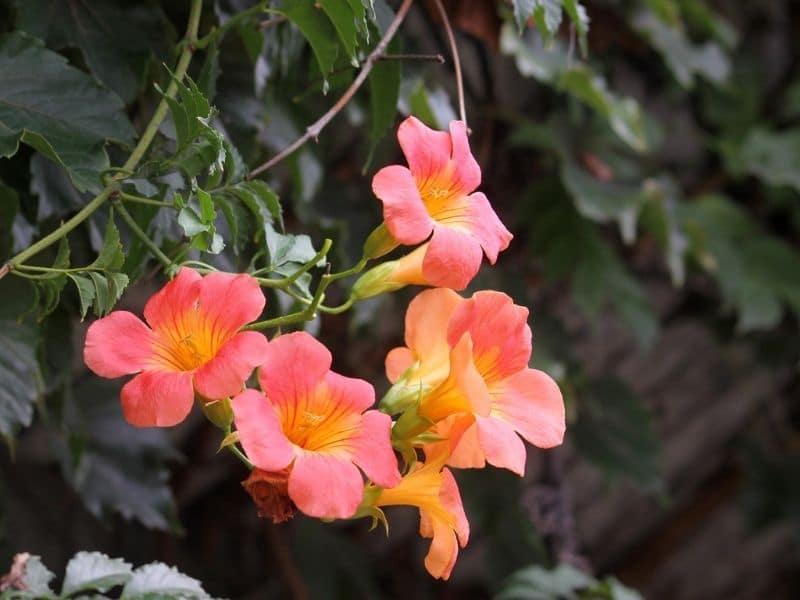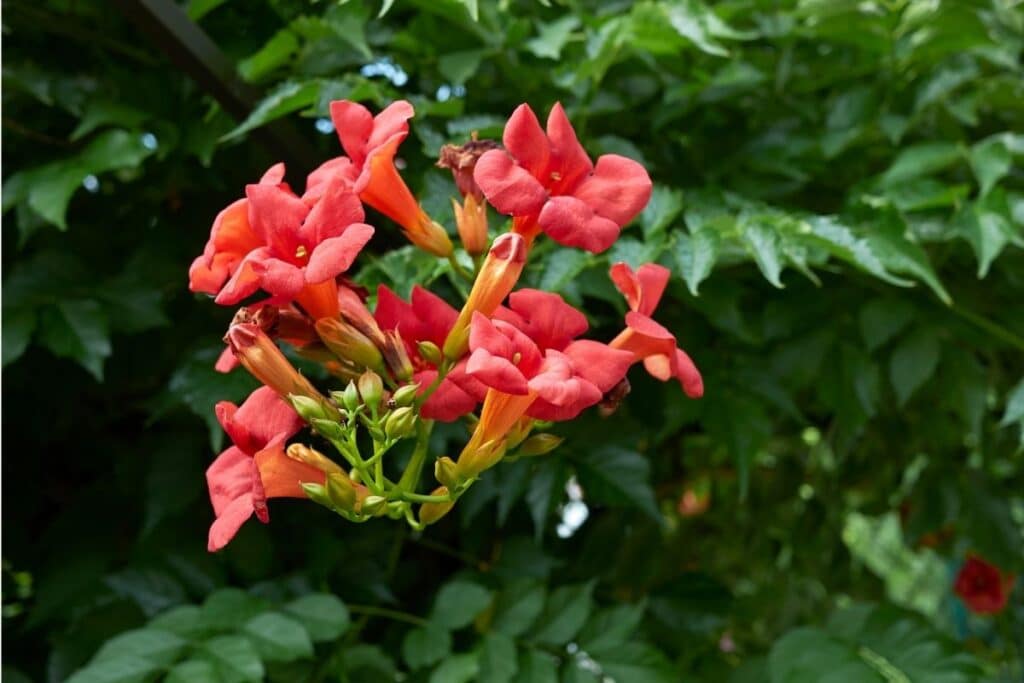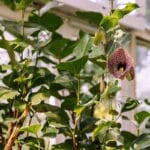During stressful times, people often turn to nature to find some peace and relax. Big bushy trees and colorful flowers are what catch the eye of most people. The Trumpet Vine (Campsis radicans) is one of our floral head-turners because of its flower shape and color.
As a fast growing perennial vine, caring for this plant is trouble-free. However, if left untouched it can cause damage to existing vegetation and fixtures.
Botanical Information
Campsis radicans is commonly known as the Trumpet Vine but is also known as the Trumpet Creeper, Devil’s Shoestring, Cow Vine, Hellvine, Common Trumpet Creeper, Hummingbird vine, Cow Itch Vine, and Foxglove Vine. It belongs to the Bignoniaceae family, which is characterized as woody climbers with flamboyant flowers.
Identifying the plant is the first step to knowing how one can take care of it. Written below are information and characteristics about Trumpet Vine
Spatial Distribution
Trumpet Vines are native to Eastern North America. They are usually seen in tropical regions but are also suitable to grow in USDA zones 4 to 9.
Leaves
Campsis consists of pinnate leaves, wherein its leaves are usually in pairs located at the opposite sides of the stem, with serrated margins. There are 4 to 6 leaflet pairs and one leaf on the tip which can grow up to 12 inches in length. The leaves have a dark green color on the upper side and a lighter shade below.

Flowers
Its common name, Trumpet Vine, was coined due to its trumpet-shaped flowers. Orange, scarlet, red, and yellow are the usual colors of this plant.
It is incompatible to self-pollinate, hence the presence of pollinators is highly beneficial. These trumpet vines bloom usually in June, July, August, and September.
Fruit
The woody vine produces a green pod that is relatively flat but has a slightly round cross-section. It can grow as long as 6 inches with ridges on opposite sides of the pod. As it matures, it turns brown and dries up.
Growth and Development
Trumpet creepers can grow up to 35 feet long and 10 feet wide, thanks to their rootlike aerial stems. This modified plant part gave rise to the names devil’s shoestring and hellvine. Its flowers bloom and develop vastly but slowly decline through the weeks.
As an aggressively growing plant, care and propagation are not much of a problem. However, being left to grow without any human intervention might cause a problem to the site.

How to Grow Trumpet Vine
Sunlight Requirement
This plant loves to be under the full sun, as it helps in the production of its eye-catching colors. It can also be planted under partial shade but would have some difficulty in producing showy trumpet shaped flowers.
Water Requirement
Trumpet vines are drought-tolerant but flourish with an inch of water weekly, mainly through rainfall. During scorching summers, provide deep watering if leaves wilt.
If you’re growing newly planted vines, it’s important to water trumpet vines more frequently (once a week) for the first couple of months to help them establish their roots. Less is more in most cases, so let the soil dry before providing more water.
Soil Requirement
For the soil pH, this plant grows better in neutral to acidic soil conditions and has a high calcium carbonate tolerance. Also, soil with good porosity and drainage is recommended.
Some of the soil types that are compatible with this trumpet vine plant are limestone-based, medium to clay loam, sandy, and sandy loam. It is important to note that moderately moist soil is ideal for the growth of this flowering species.
Temperature
To prove its versatility as a vine, Campsis is tolerant to hot and cold temperatures. But these plants prefer hot, humid climates.
Fertilizer Application
Campsis does not require any fertilizer as long as the soil is rich enough with the common macro and micronutrients a plant needs.
Pruning
Since the Trumpet Vine can easily grow out of control, scheduling maintenance practices such as pruning are proven to be advantageous to promote new growth. Pruning is suggested to be done during the fall or early spring and can be cut down with only a few flower buds remaining.
Deadheading, an act of removing wilted flowers, can be done to avoid the unwanted spread of the vine. Also, it can give the plant a better aesthetic appearance as desired in most landscapes.
Pruning of Trumpet Vines is an important activity as they can grow and be harmful to other plants and fixtures.
Propagation
Campsis also goes by the name Hummingbird vine because hummingbirds are one of its major pollinators. The flower’s elongated structure and the hummingbird’s beak make it a perfect fit. Although, honeybees and bumblebees are also up for the job.
Seeds from the pods can be used as planting material, along with root cuttings and semi-hardwood cuttings. Applying root hormones to the cuttings can aid in root production which can hasten the growth of the plant.
Seed Collection
Since this plant blooms vigorously, some seeds might get wasted as pods turn brown, dry up, and split open around 2 to 3 months upon flowering. Harvesting seeds from ripe pods and then air-drying them is recommended. After drying the seeds, they can be stored in an airtight container and put in a refrigerator or cold storage.
Landscape Use
In landscape designs, vines such as Campsis are used to bridge the gap between man-made fixtures and vegetation. It gives a smooth transition throughout the landscape. It can be used in fences, trellises, walls, arbors, and privacy barriers.
Aside from the color and texture, the Trumpet Vine adds to the landscape. It also attracts butterflies, bees, and hummingbirds which could give the space a more natural vibe. This makes it a great addition to pollinator gardens.
Potential Harm
Trumpet creeper produces a sap that is thought to be poisonous when ingested and can cause skin irritation.
Additionally, common problems with trumpet vines include invasive growth, where the plant can become aggressive and spread rapidly, potentially taking over other plants nearby.
Trumpet vines are susceptible to pests such as aphids and spider mites, which can affect their overall health and flowering. Careful monitoring, proper pruning, and addressing pest issues promptly can help manage these challenges.
Commonly Known Varieties of Trumpet Vines
To spice up the landscape, one can use different varieties of Trumpet Vine. One of the common and less vigorous varieties is Campsis radicans ‘Apricot’. Its name is derived from its flowers that are apricot in color.
Then, for those who prefer a more compact and easier to manage variety, Campsis radicans ‘Indian Summer’ is the one for them. Besides, it blooms with flowers that have a red to a yellow-orange gradient.
Lastly, Campsis radicans ‘Flava’ is best to provide bright yellow flowers that could grow up to 3 inches in length that will surely give the landscape the feeling of grandeur when placed and grown properly.
FAQs
Is the trumpet vine poisonous to humans?
While trumpet vine (Campsis spp.) is not typically considered highly toxic, contact with the plant may cause skin irritation in some individuals. It’s advisable to avoid contact with the sap and to wash hands thoroughly after handling.
What is trumpet vine good for?
Trumpet vine is valued for its ornamental qualities, producing vibrant, trumpet-shaped flowers that attract hummingbirds and butterflies. It is commonly grown as a decorative climbing plant.
Are trumpet vines messy?
Yes, Trumpet vines can be considered messy due to their aggressive growth habit, which may result in the shedding of leaves, flowers, and seed pods. Regular pruning and maintenance can help manage their growth and reduce potential messiness.
Are trumpet flowers edible?
The trumpet vine’s flowers are not typically considered edible and are not cultivated for culinary purposes. Ingesting parts of the trumpet vine may cause discomfort and is not recommended.
Up next:
References
Reference list:
https://plants.usda.gov/core/profile?symbol=cara2
http://www.botany.hawaii.edu/faculty/carr/bignoni.htm
https://bsapubs.onlinelibrary.wiley.com/doi/abs/10.1002/j.1537-2197.1982.tb13241.x
https://www.clemson.edu/cafls/demo/plant_profiles/campsis-radicans-trumpet-vine.html
https://www.invasivespeciesinfo.gov/species-type
Close
*image by simonapavan/depositphotos







